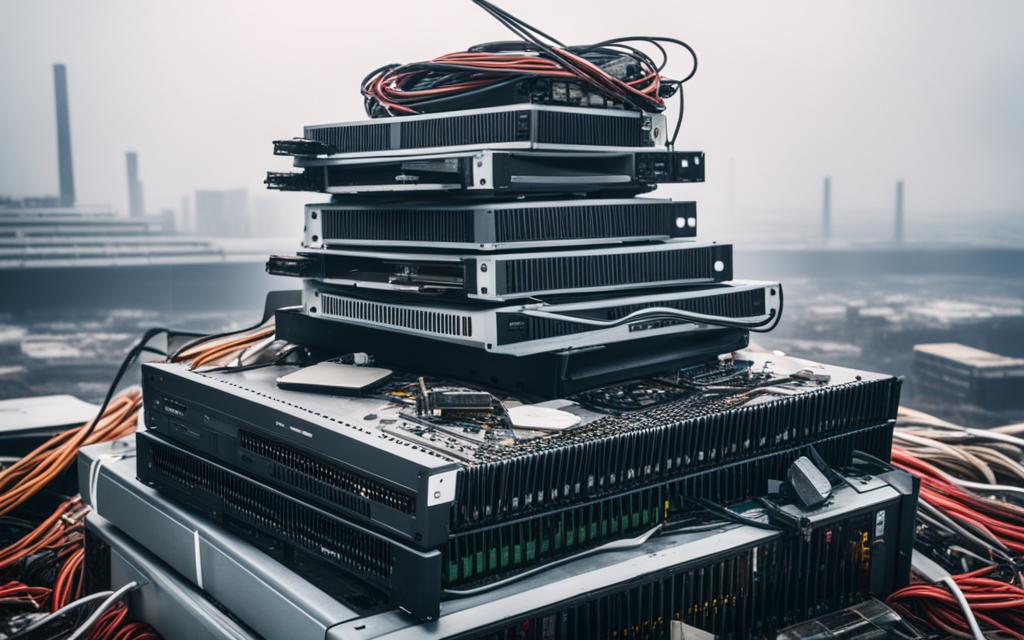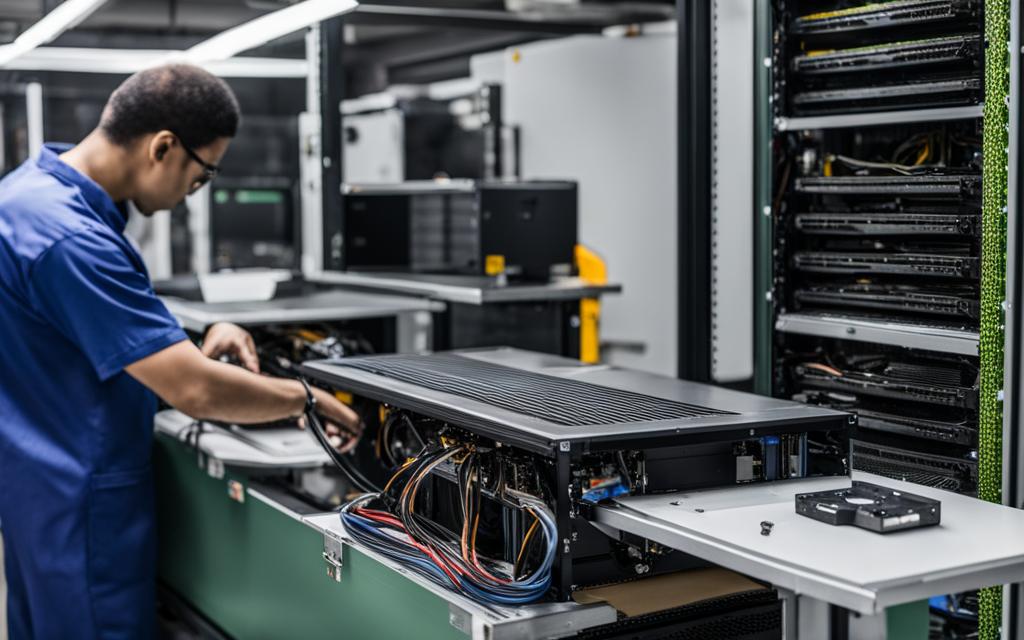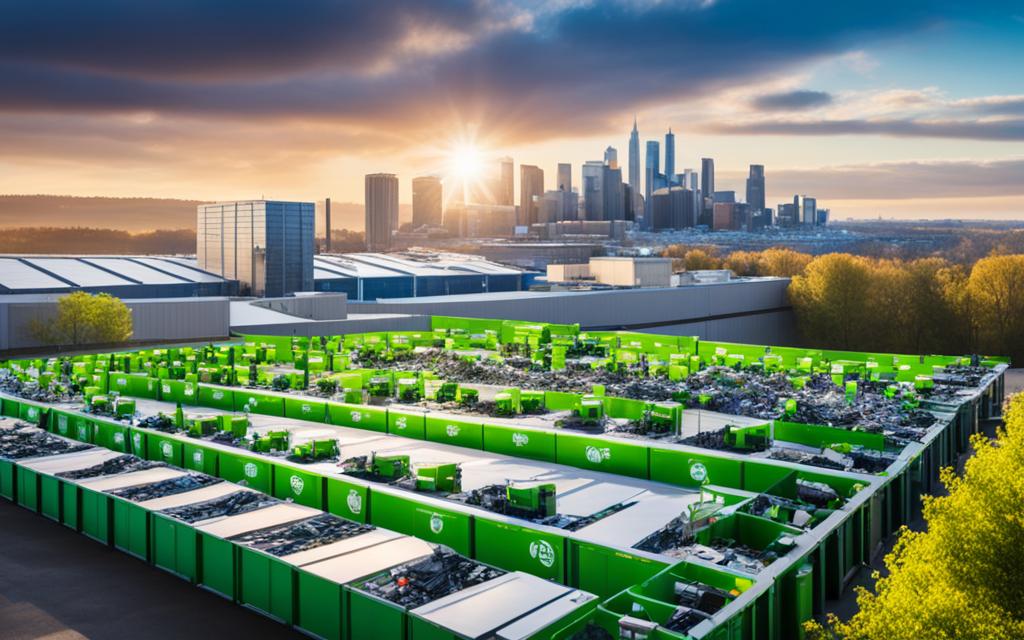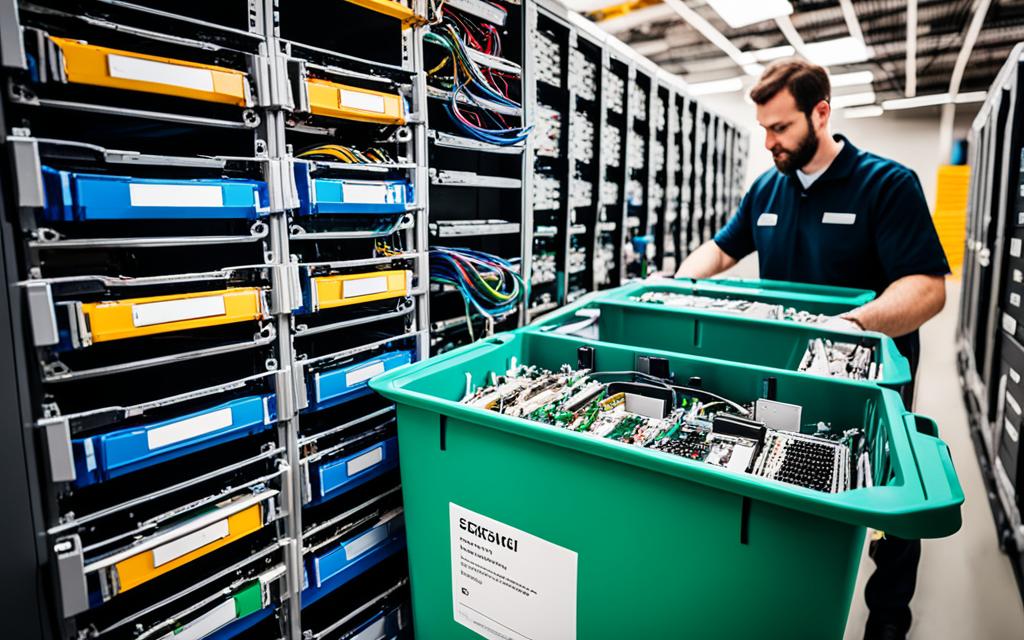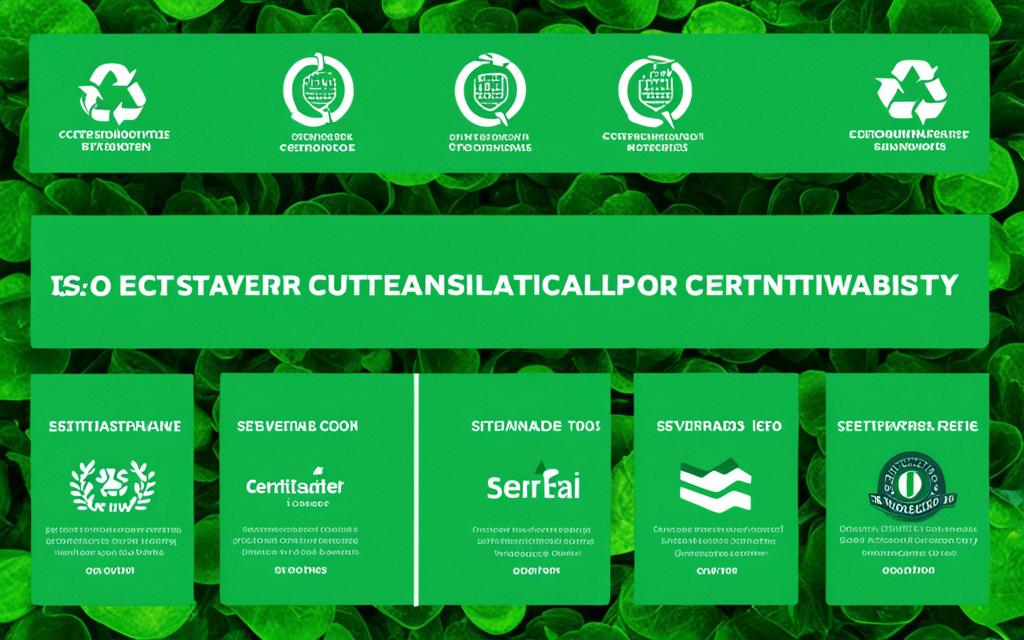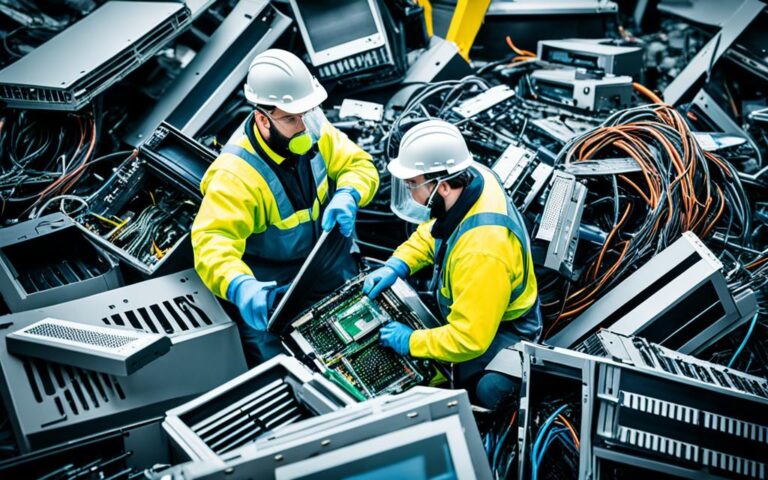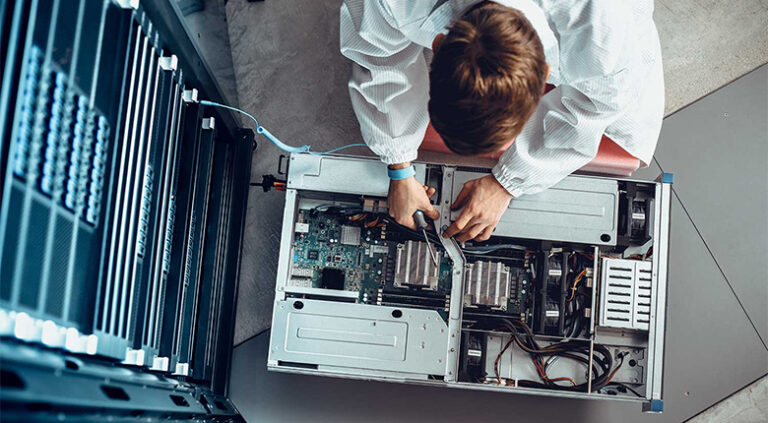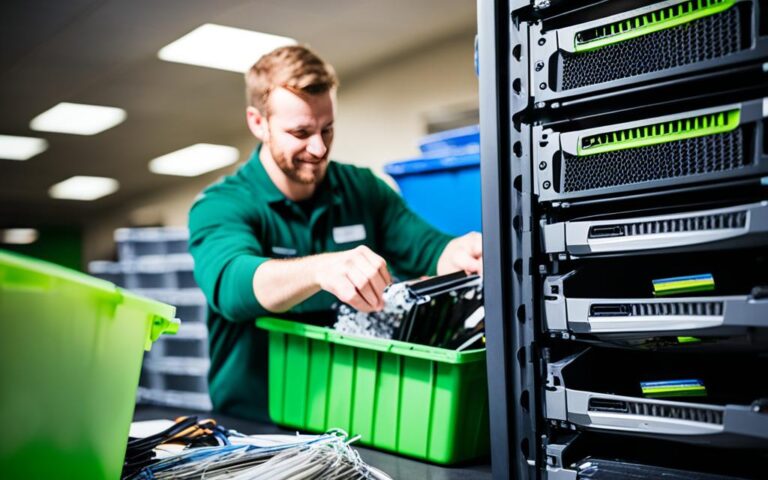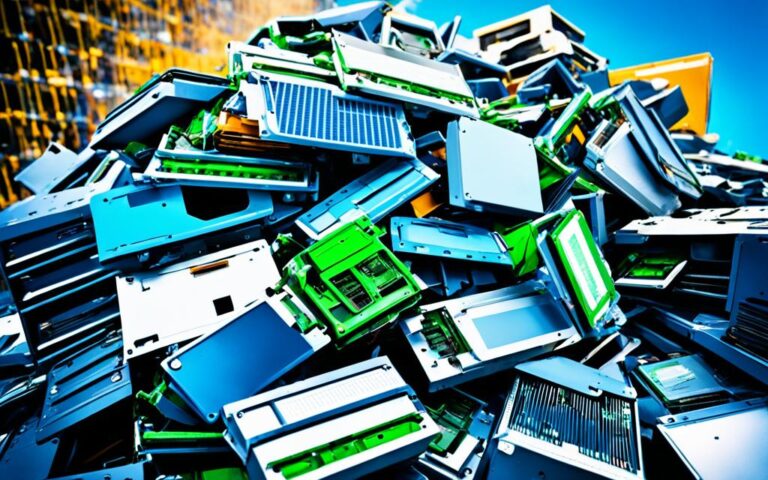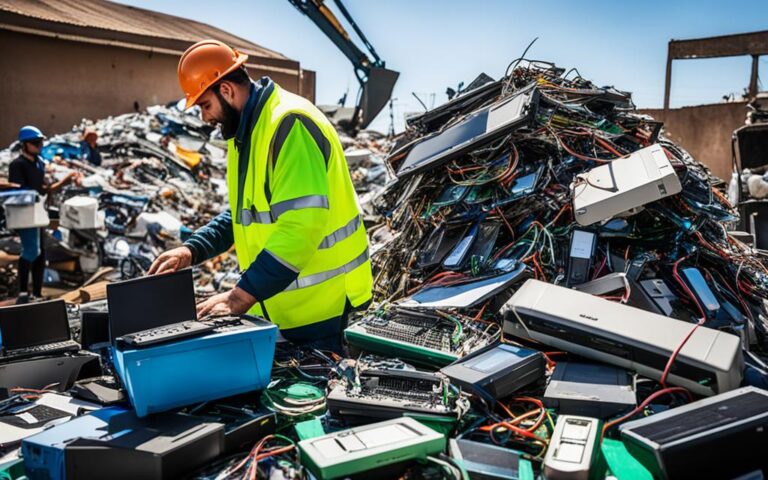The Lifecycle of a Recycled Server: From Collection to Reuse
As technology advances, the need for responsible disposal methods for IT equipment, such as servers, becomes crucial. This article explores the recycled server lifecycle, from the initial collection to its innovative reuse. It delves into the importance of server recycling in the UK and highlights the environmental and commercial benefits it brings. The goal is to ensure sustainability in the tech industry by promoting proper disposal and encouraging the reuse of valuable materials and components.
The Challenge of Server Waste Stream
Servers are integral to modern technology infrastructure, but they come with a downside – the server waste stream. This waste stream consists of both valuable and toxic materials found within servers, making their proper disposal crucial for the environment and human health.
Currently, the recycling and reuse stages of the server lifecycle are not sufficient to address the challenges posed by the server waste stream. To overcome these challenges and maximize the potential for a sustainable server recycling process, several key areas need attention:
- Improved Life Cycle Analysis and Specification Development: Enhancing the analysis and specification development during procurement can help identify servers with longer lifespans and easier recyclability. By considering these factors upfront, the server waste stream can be effectively minimized.
- Reduced Shredding: Shredding is a common practice in the recycling process, but it can result in the loss of valuable materials. Implementing strategies to reduce shredding, such as targeted dismantling, can enable the recovery of valuable components for reuse.
- Increased Dismantling and Reuse: Instead of focusing solely on recycling, efforts should be made to prioritize dismantling and reuse at the end of the first owner’s use. Reusing components and whole servers helps extend their lifespan and prevents unnecessary waste.
- Establishment of a Trackable Reuse Business Model: Implementing a trackable reuse business model enables the efficient monitoring and management of the server lifecycle. This approach ensures that servers are properly tracked, reused, and recycled, minimizing waste and maximizing the value of valuable materials.
Addressing the challenges posed by the server waste stream not only brings about environmental benefits, reducing the impact of e-waste, but also offers commercial advantages. By recycling or reusing servers effectively, businesses can recover valuable materials, reduce the dependence on virgin resources, and contribute to a circular economy.
Next, let’s explore the environmental impact of server recycling and the role it plays in responsible e-waste management.
The Environmental Impact of Server Recycling
Improper disposal of servers can have significant environmental consequences. When servers end up in landfills or are incinerated, toxic substances such as mercury, cadmium, and lead are released into the environment. This poses serious risks to ecosystems and human health, contributing to pollution and the degradation of natural resources.
However, responsible server recycling plays a crucial role in mitigating these environmental impacts. By recycling servers, valuable materials like iron, copper, aluminium, and precious metals can be recovered and reused. This reduces the depletion of natural resources and minimizes the carbon footprint associated with extracting and manufacturing new materials.
Server recycling not only prevents the environmental harm caused by e-waste but also contributes to a more sustainable future.
The Benefits of Server Recycling for the Environment
1. Conservation of Resources: Recovering valuable materials from recycled servers helps conserve natural resources, such as minerals and metals, which are finite in supply.
2. Waste Reduction: By recycling servers, less e-waste ends up in landfills, reducing pollution and the environmental impact of hazardous materials.
3. Carbon Footprint Reduction: The recycling process emits fewer greenhouse gases compared to manufacturing new servers. This helps to combat climate change and promote sustainable practices.
The Role of Server Recycling in Responsible E-Waste Management
Server recycling is an essential component of responsible e-waste management. E-waste, which includes discarded electronic devices like servers, has become a global environmental challenge. By recycling servers, we can divert e-waste from landfills and ensure that valuable materials are recovered and repurposed.
“Recycling one million laptops saves enough energy to power over 3,500 homes for a year.” – Environmental Protection Agency (EPA)
By choosing to recycle servers, we can make a significant impact in reducing the environmental harm caused by e-waste.
| Environmental Impact | Server Recycling | Irresponsible Disposal |
|---|---|---|
| Release of toxic substances | Prevented | Contributes to pollution |
| Conservation of natural resources | Materials are recovered and reused | Resources are wasted |
| Waste reduction | Less e-waste in landfills | Increased pollution from hazardous materials |
| Carbon footprint reduction | Emit fewer greenhouse gases | Manufacturing new servers creates more emissions |
The Economic Benefits of Server Recycling
When it comes to server recycling, the benefits extend far beyond environmental responsibility. In fact, businesses can reap substantial economic advantages by embracing this sustainable practice. By refurbishing and reusing servers, companies can unlock significant cost savings compared to purchasing new equipment. Additionally, the server recycling process presents opportunities for revenue generation through the sale of recycled materials.
“Investing in server recycling not only contributes to a more sustainable business model but also supports economic growth and job creation.”
“Server recycling not only benefits the environment but also offers substantial economic advantages.”
The Cost Savings of Server Recycling
Purchasing brand-new servers can be a significant expense for businesses. However, by opting for server recycling and refurbishment, companies can enjoy substantial cost savings. Refurbished servers offer a cost-effective alternative without compromising on performance or reliability. By utilizing recycled servers, businesses can redirect their budget towards other critical areas, such as innovation and expansion.
The Revenue Generation Potential
Server recycling also presents unique revenue generation opportunities. Companies can sell recycled materials recovered from the servers, such as metals and plastics, to recycling facilities. These materials can be processed and transformed into new products, providing a sustainable source of income. By contributing to the circular economy, businesses not only profit from server recycling but also support the growth of a thriving industry.
Furthermore, investing in server recycling can stimulate job creation in the recycling and refurbishment sectors. As more businesses embrace sustainable practices, the demand for skilled professionals in these fields increases. This not only benefits the economy but also provides individuals with employment opportunities in the growing green technology sector.
The Process of Server Recycling
The server recycling process involves several important steps to ensure the proper disposal and recovery of materials. By following this process, businesses can contribute to a more sustainable approach to server management.
Step 1: Initial Assessment and Potential for Reuse
Before beginning the recycling process, the equipment undergoes an initial assessment to determine its condition and potential for reuse. Servers that are still functional can be refurbished and resold, reducing the need for new equipment and extending their lifespan.
Step 2: Data Sanitization for Secure Destruction
Data sanitization is a critical step in the server recycling process to ensure the secure destruction of sensitive information. This involves permanently removing all data stored on the servers, protecting businesses from potential data breaches and maintaining data security standards.
Step 3: Disassembly and Component Separation
Once the data has been securely wiped, the equipment is disassembled, and the components are separated for further evaluation. This allows for the identification of components that can be refurbished or reused, reducing waste and conserving valuable resources.
Step 4: Testing for Functionality
Components that have been separated are tested for functionality to ensure that they meet the required performance standards. This step helps determine which components can be reused in other systems or sold for secondary use.
Step 5: Material Recovery and Disposal
During the disassembly process, valuable materials such as metals and plastics are recovered for recycling. These materials can be repurposed for other manufacturing processes, reducing the need for virgin resources. In contrast, hazardous substances are safely disposed of to prevent environmental contamination.
Step 6: Choosing a Certified Recycler
Choosing a certified recycler is crucial to ensure compliance with environmental regulations and the proper management of the recycling process. Certified recyclers have the expertise and resources to handle the server recycling process responsibly, maximizing material recovery and minimizing environmental impact.
By following these steps, businesses can contribute to a more sustainable server lifecycle by diverting waste from landfills, promoting material recovery, and reducing the depletion of natural resources.
| Step | Description |
|---|---|
| 1 | Initial Assessment and Potential for Reuse |
| 2 | Data Sanitization for Secure Destruction |
| 3 | Disassembly and Component Separation |
| 4 | Testing for Functionality |
| 5 | Material Recovery and Disposal |
| 6 | Choosing a Certified Recycler |
The Importance of Reuse in Server Lifecycle
Reusing servers is an essential component of the server lifecycle. It helps extend the lifespan of servers, reduces the need for new equipment, and conserves valuable resources. By refurbishing and repurposing servers, businesses can minimize waste and contribute to a more sustainable approach to server management.
Benefits of Reuse:
- Extending server lifecycle: Reusing servers allows businesses to maximize the lifespan of their equipment, reducing the frequency of new purchases and minimizing electronic waste.
- Reducing waste: By refurbishing and repurposing servers, businesses can minimize the amount of electronic waste that ends up in landfills, helping to protect the environment.
- Conserving valuable resources: Reuse reduces the demand for new materials, such as rare metals and plastics, which are commonly found in servers. By conserving these resources, businesses can contribute to a more sustainable future.
In the words of sustainability expert Emma Johnson, “Reusing servers is not just good for the environment; it’s good for the bottom line as well. It’s a win-win situation that allows businesses to extend the life of their servers while reducing waste and saving on costs.”
Reusing servers not only benefits the environment but also offers economic advantages. It can result in substantial cost savings compared to purchasing new equipment. Additionally, the refurbishment and repurposing of servers create job opportunities in the refurbishment industry, further supporting economic growth and development.
Case Study: XYZ Corporation
| Metrics | Before Reuse | After Reuse |
|---|---|---|
| Number of Servers | 100 | 60 |
| Cost Savings | £50,000 | £30,000 |
| Job Creation | N/A | 10 positions |
XYZ Corporation, a leading tech company, implemented a server reuse program, resulting in a significant reduction in the number of servers needed, cost savings of £20,000, and the creation of 10 new jobs in the refurbishment and repurposing sector. This case study showcases the real-world benefits of server reuse, both in terms of financial savings and job creation.
By prioritizing reuse in the server lifecycle, businesses can not only reduce waste and conserve resources but also contribute to a more sustainable and economically viable future.
The Need for Responsible Server Disposal
When it comes to server disposal, responsible practices are crucial to protect both the environment and data security. Servers contain hazardous materials that, if not disposed of correctly, can pose significant risks to the ecosystem and human health. Moreover, failing to securely wipe or destroy data on servers can lead to data breaches and compromise sensitive information.
By prioritizing responsible server disposal, we uphold our commitment to environmental sustainability and data security. Through proper handling and disposal methods, we can minimize the harm caused by hazardous materials and ensure that valuable resources are safely recovered. This responsible approach aligns with the growing demand for ethical and sustainable practices in the tech industry.
Responsible server disposal is not just about protecting the environment; it’s also about safeguarding confidential information and maintaining trust with our stakeholders.
The Hazards of Improper Server Disposal
Server hardware contains toxic substances such as mercury, cadmium, and lead, which can seep into the soil and water when servers are disposed of improperly. These hazardous materials can contaminate the environment, jeopardizing the health of wildlife and communities near disposal sites.
Furthermore, obsolete servers are often replaced without proper data sanitization, leaving sensitive information at risk. Without secure data destruction protocols, outdated servers can become vulnerable targets for cyberattacks and data breaches, resulting in significant financial and reputational damage for businesses.
Ensuring Data Security and Environmental Protection
To protect data security and the environment, responsible server disposal should follow a comprehensive approach. This includes:
- Implementing strict data sanitization practices to securely wipe all sensitive information from servers before disposal.
- Working with certified recyclers who adhere to environmental regulations and employ safe and responsible practices in handling hazardous materials.
- Promoting server recycling initiatives that prioritize material recovery to reduce the need for virgin resources and minimize electronic waste.
By adopting these measures, we can mitigate the health risks associated with hazardous materials and contribute to a more sustainable future. Responsible server disposal not only safeguards the environment but also protects businesses and individuals from data security breaches.
The Benefits of Responsible Server Disposal
Responsible server disposal offers a range of benefits, including:
- Environmental Protection: By safely disposing of servers and recovering valuable materials, we reduce the ecological impact of hazardous substances and prevent the depletion of natural resources.
- Data Security: Secure data sanitization and disposal protocols safeguard sensitive information, protecting businesses and individuals from potential data breaches.
- Sustainability: Prioritizing responsible server disposal aligns with corporate social responsibility goals and demonstrates commitment to sustainable practices.
- Compliance: Adhering to environmental regulations and data protection laws ensures legal compliance, avoiding potential penalties and reputational damage.
By embracing responsible server disposal, we can minimize the environmental footprint of our operations, protect data confidentiality, and contribute to a sustainable future for businesses and the planet.
Conclusion
The recycled server lifecycle plays a pivotal role in achieving sustainable server management in the UK tech industry. By adopting proper server recycling practices, businesses can contribute to the reduction of e-waste and the conservation of valuable resources. Not only does server recycling benefit the environment, but it also offers economic advantages, including cost savings and job creation.
By prioritizing responsible server disposal, businesses can pave the way for a more sustainable future. This includes ensuring data security standards are upheld during the recycling process to mitigate potential data breaches and safeguard sensitive information.
Server recycling is a critical step toward establishing a closed-loop supply chain, where valuable materials and components are reused and repurposed. By embracing this approach, we can create a more sustainable and efficient server lifecycle, reducing waste and promoting a greener, more environmentally conscious IT industry in the UK.
FAQ
What is the lifecycle of a recycled server?
The lifecycle of a recycled server begins with the collection of the equipment, followed by data sanitization, disassembly, and the separation of components for refurbishment or reuse. Valuable materials are recovered, and hazardous substances are safely disposed of. Choosing a certified recycler ensures compliance with environmental regulations.
Why is server recycling important?
Server recycling is important because servers contain valuable and toxic materials. Improper disposal can have significant environmental consequences, releasing toxic substances into the environment. Recycling servers allows for the recovery of valuable materials, reduces the depletion of natural resources, and minimizes the carbon footprint.
What are the economic benefits of server recycling?
Server recycling offers substantial economic advantages. By refurbishing and reusing servers, businesses can save costs compared to purchasing new equipment. Additionally, the recycling process creates jobs and generates revenue from the sale of recycled materials.
What is the process of server recycling?
The process of server recycling involves assessing the equipment’s condition, sanitizing data, disassembling the equipment, separating components for refurbishment, recovering valuable materials, and safely disposing of hazardous substances. Choosing a certified recycler is essential for proper management.
Why is reuse important in the server lifecycle?
Reuse is important in the server lifecycle because it extends the lifespan of servers, reduces the need for new equipment, and conserves valuable resources. By refurbishing and repurposing servers, businesses can minimize waste and contribute to a more sustainable approach to server management.
What are the risks of improper server disposal?
Improper server disposal poses risks to the environment and data security. Servers contain hazardous materials that can harm the environment if not disposed of correctly. Failing to securely wipe or destroy data on servers can result in data breaches and compromise sensitive information.

